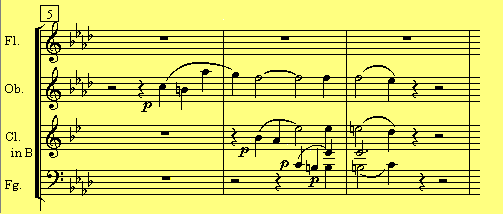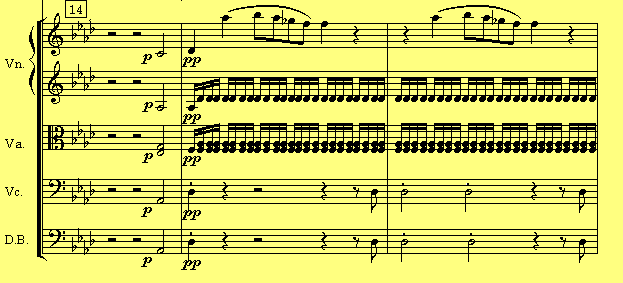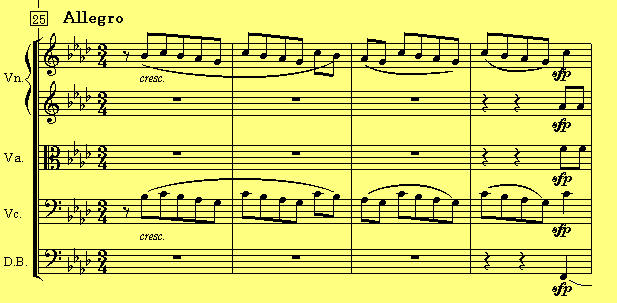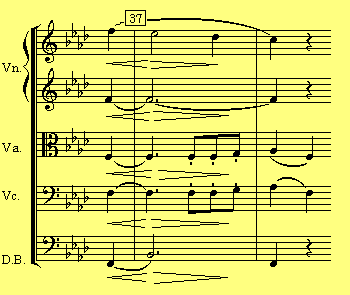
(2)
Melody that clarinet starts this time

It differs from the melody of oboe from bar 5. It goes forward frankly by ?.
The
meaning of the appoggiatura in the beginning of bar 6
seems to be already incorporated. It explains it’s plan
accordingly and obtains consent.
The other instruments resonate to it. From the second time of
bar 13, there is an energy to act together against difficulty of
the beginning of bar 14 in <>.
Oranien is heard that doesn’t consent yet. It’s the following auftact of string.
*Break
How vexing and intricate to consider! So far you may think so. I become tired, too.
It takes about 2 minutes, no matter how slow it may be performed so far. So many things are done.
Please
listen to a CD around here. Only neat performance, I recommend.
Listening is never a bad matter.
It's music that we are doing now, so I must explain by the sound “itself”. However misunderstanding goes together, and preconception or thought etc. disturb us in our correct understanding. So I try to explain by words insistently.
But I think I could say less than 1% of what I want to say. “You had better listen to my performance!”, I want to shout.
“Then you should rather produce CD.” I want to do. But
if I explain such things entirely to players, there must be
nobody when the explanation is finished.
I want to perform with people that understand without
explanation, if I can.
Is it a dream? No, the dream comes true this time and I continue ahead.
Beginning of next music

From bar 15, music starts with entirely new tempo (stream). Whether the indicated meter is same, the tempo (stream) sometimes differs.
The development of the story from here is maybe the
argument between Egmont and Oranien. Egmont insists so far and
Oranien speaks on behalf of people.
Act Two, scene two, at Egmont’s residence in the drama,
their opinions run parallel and become apart. It can be seen as
if the tempo represents that scene.
The motif is repetition of beforehand, so situation of music is the same. Therefore it is the opposition between the motif of “half note with marcart ” and the melody of clarinet. The motif is insistence of Oranien and people. The melody is advanced on that of oboe, that is, Egmont.
Then what is the tremolo of Ⅱviolin and viola?
It represents the tension of their opposition well. So it starts with slightly and becomes to opposite quite rigorously then leaves with resignation.
Conversation between Egmont and Oranien
There are half notes with “pp ” bars 15-21 by fagotto and horn. They are two or three times. And it’s quite difficult point.

It is just a simple series of notes that seem to be indescribably “chilly” or not important if you read only your score part here.
This part is playing the role to represent the story, that is, the two never part in quarreling with each other, but leave not yielding the difference between their manners whether they have their friendship. The timbre must not be “curt” or “quarreling”, but need to be warm with friendship.
At first, onlookers (spokesmen of audience’s will) listen to both opinions and “nod” (maybe the notes imitate this) deeply to both insistences. “Nod” is gradually getting more and more slight, then become like shaking head “there is no way” at last. This part should be this process.
There is no “nod” after bar 22. It may mean “resignation”.
But it depends on ability whether “friendship”, that they
care each other, can be remained there. In order to remain, tempo
and also volume can not be down. If they are down, only “worry”
remains and seem to be just “uneasy”.
Bar 24 before “Allegro ” is important.
Well, it must go for a perfect end. The perfect end should be on the beginning of the next bar.
The development of drama changes at “a moment”. It is
this first time.
It is the moment that “he has gone”.
There is “therefore” at the moment, “determination”
appears as ?, it does not end completely, then rushes into “Allegro
”.
Therefore the melody of this ? needs to be paid attention “not to lessen the tension” for determination. Volume and also tempo need exaltation that seems to crescendo at a glance (overhearing). Only “semple pp ” can realize this.
The motif of Oranien (horn) resounds in the distance like an echo.
3.Interpretation
(the 2nd part)
The scene of this part, Act Four, scene two, is the last one that new governor-general Alba and Graf Egmont bandy words with each other acutely. Suddenly, it is the climax. Overture is “highlight” of main theme, and so attractive.
Beginning of the 2nd part

The beginning of the 2nd part 3/4 Allegro starts with two meter unexpectedly, not with three meter.
Written by 3/4 meter in the score, but from the second bar (bar 25), hemiora (three times two beat are there within two bars of three beat) is there that is sometimes seen in waltz. This is just the situation in haste. It is in a hurry to go forward hastily.
*) I wrote digit notation separate to understand easily. Slur is thought to show bowing.
Waltz was very much in fashion in that time.
This “Allegro ” is not waltz, of course. Not “cheerful”
like “waltz”, but “encouraged” feeling (cause he has made
up his mind) to try to face to governor-general comes out.
It may be his “cheerfulness” that could be imagined from the original work. If it is two time, that is too “pathetic”.
I think you can understand that this melody is based on that of clarinet which is developed from the first motif of oboe. But the sound of first auftact (it may not fit as a term however), that is the part of ? (the second time from bar 15 afterward), is not there. It means to take off “but!” (the beginning sound of B) from “but do so!”. And the determination comes clear.
The development of this motif repeats many times. And “strong faith” that commentary says is stressed.
Downward melody from “sfp ”

This “sfp ” is indicated under the sound of auftact of downward melody that was taken off once. It’s the sound of “but!”. And it is used stressed again here.
Then the meaning of this “but!” sounds like “so!”
that adds confidence to own thought again. The meaning is quite
important, therefore it must be “sfp ”.
Only to play strongly is frivolous. It may mean “molt
espressivo ”.
Or if there is decrescendo after this “sfp ” sound, it’s not enough, either.
It is natural that strong time (the first time) should be recognized. That is to say, this ? is not “in a hurry” to forward. It must go to the strong time of the highest sound at the beginning of the next bar after enough standing.
Then long downward melody follows.
There is slur above ? in bar 24 here. It accounts for hoping to come to an end “at a stretch”.
But this pattern of downward melody is just twice. Therefore it doesn’t develop.
Development of auftact
After the repeat of downwards melody twice, the variation of the sound of auftact with “sfp ” comes. Going back more, it’s the later half of the first melody of oboe in bar 6.

“But : aber (Gr.)!” is developed into “so!”, further the insistence is carried on from here.
Is this for what?
When you think what a scene this 2nd part is, the conclusion is caught soon.
It’s the effort to persuade new governor-general Alba.
Delayed auftact demands strongly, but ? accompanied with three ♪ of violin and viola (it’s the same with the motive of fate) shows denied opinion against it.
And then, Egmont says “Was ist das nicht (Gr.)?”. His persuasive tone with auftact becomes severely with downward passage. Afterward it changes into a bluff “otherwise : andernfalls (Gr.) (a riot breaks out!)” whether with upward passage again.

The governor-general says “No : nicht (Gr.)!” persistently. His strong tone is in the beginning of the bar by double bass (contrabass) and violoncello (cello), etc.
